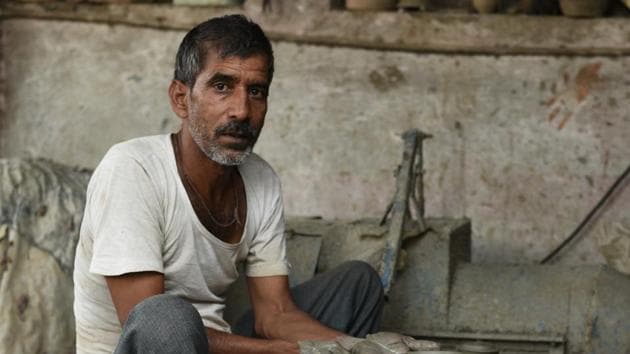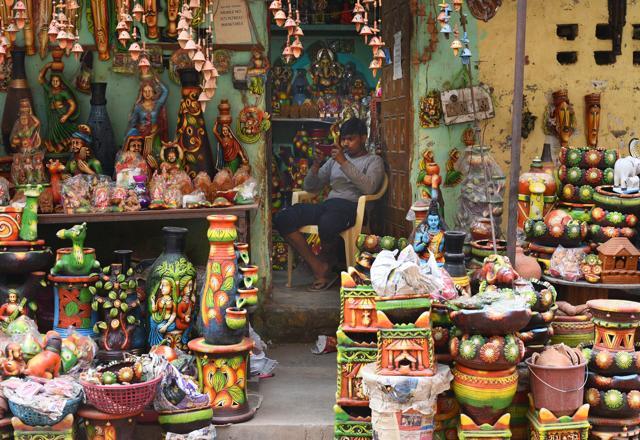No bright Diwali for this potters’ colony
With sales of diyas and other earthenware dipping like never before, many potters in Kumhar Gram fear that their colony will soon become a museum of lost art.
“Can you imagine the pain of an artisan having to cycle a rickshaw for a living,” asks Shayam Lal Prajapati, as he shapes a diya (earthen lamp) on a potter’s wheel. We are in his workshop, on the second floor of his house in Kumhar Gram, better known as potters’ colony in west Delhi’s Uttam Nagar area.

“But these days there are few takers for our earthenware, and, with my earnings dipping like never before, I have been forced to cycle rickshaws. I make some money only during Diwali, which too has dried up this year,” says the 44-year-old potter.
While in the last few years, Kumhar Gram, India’s largest potters’ colony, has become a tourist hub, with several tour operators and guides bringing in foreigners for an “unmatched cultural experience”, these potters are struggling for survival. Diwali, the biggest sale season, has failed to bring any cheer for them.

“What we get now are tourists wanting to be photographed with us and try their hands at the wheel, but not many traders wanting to buy our wares. Many people here have already given up pottery,” said Prajapati, whose journey from a potter to a rickshaw puller seems to have taken a heavy emotional and physical toll on him. During Diwali, he usually makes about 1,000 diyas a day, which are sold for ₹400, almost equal to what he makes pulling a rickshaw.
For the uninitiated, the colony is a quaint, congested place of about 500 houses, with a main street dotted with shops running across the length of the colony and many mini alleys, which have potters workshops, branching off it. On display outside the houses are a range of colourful earthenware – diyas, flower pots, vases, bowls, wall hangings and bird-feeders, among others. “Less than a week to go for Diwali, but most of our stock remains unsold,” said potter Lal Chand, 47.
For “evidence”, Chand takes us inside his house and shows sacks of unsold diyas of different shapes. And he seeks to put the problem in perspective through numbers. “I have about 100,000 unsold diyas. Every year, we start making them four months before Diwali, a period during which we hope to earn enough to see us through the year because hardly anything sells during rest of the year,” he said
He blames his woes on what he calls people’s “growing fascination” for fancy Chinese lights and other Chinese utility wares.
But Harkishan, 63, who is called “pradhan (village head)” by everyone in the colony, blames people’s shifting tastes and sensibilities towards traditional artisans. “Plastic, glass, and aluminium wares have replaced earthenware in homes. There is a declining appreciation for handmade and handcrafted items,” said Harkishan, who has won several awards and is also a “Shilp Guru”, an honour conferred by the Union government on a master craftsperson.
His house is a little pottery museum — in the living room there are shelves running across the entire length of the wall with a range of pottery; on the floor are potters’ wheels he has used over the years; there are several pictures on the wall of him receiving awards from government and non-government organisations. A banner says that the place is also a government-approved centre for terracotta training.
“Many potters here are also a part of the problem; they are reluctant to learn new techniques, and improve the quality of their wares to make them more competitive in the market. They first need to treat themselves as artisans and not manual labourers. Our colony has many talented potters,” says Harkishan, who has travelled to countries such as Germany, Spain and Japan on government-sponsored tours and who was earlier this week invited by the design department of Delhi Technological University (formerly Delhi College of Engineering) for a pottery workshop for its students. “We are not just any other potters’ colony; there are over a dozen potters here who have won national awards.”
What is weighing heavily on their minds is not just lukewarm Diwali sales, but they say the colony faces “an existential threat.”
In 2017, the colony came under National Green Tribunal’s (NGT) scanner after residents of neighbouring Bindapur village filed a case against the potters of Kumhar Gram claiming that they were running industrial units in residential areas and creating pollution.
Many houses have kilns inside , which are generally fired in the night for three hours, using wood and sawdust, to bake the clay pottery. Most potters claim they have not used kilns after recent anti-pollution measure kicked in.
“Many potters in the colony received notices last year from South Delhi Muncipal Corparation. We have approached the Supreme Court for relief. Most potters here are poor and cannot afford gas kilns; the government should financially help them to do so,” says Harkishan.
Ved Prakash Prajapati, another resident of the colony, says it was wrong to call the potters as “polluters” for following traditional methods of pottery. In 1968, he pointed out, when the plots were allotted to potters, most of who are from Haryana and Rajasthan; there were only vast tracts of agricultural land all around.
“Now, the area has developed and become congested. We are suddenly called polluters. Almost 40 per cent of the families here have already given up pottery, and if our kilns are shut down, we will be forced to move back to our native village in Rajasthan,” says Ved Prakash.
Then there is another aspect: the youth are not too keen on following their parents’ footsteps.
“Our art is dying anyway as youngsters are taking up other vocations. In every house, only the aged and middle-aged people are practicing pottery now,” said Ved Prakash Prajapati.
He is not exaggerating. Many youngsters in the village have become drivers and mechanics.
“With sales going down over the years, I realised pottery is not a good livelihood option in the long run,” says Mukesh Prajapati, 22 who now works as an AC mechanic while his father continues to practise pottery.
Those who organise tours — walking tours, cycling tours, photography tours to the village, which costs anything between ₹200 to ₹2,500 — say that the colony is much in demand among foreign tourists and should not be allowed to die.
“A lot of our foreign clients make a special request to visit potters’ colony; they want to be photographed inside the potters’ houses and want to try their hands at the wheel,” said Ramit Mitra, the founder of Delhi by Foot, an organisation which organises walking tours across the city.
The Delhi Photography Club has already taken two groups to tour the colony in October alone. “There were about 70 people on the tour, including foreigners. The colony is as such a photogenic place. It is a already on the city’s tourism map; the government just needs to promote it. May be they can create a pottery museum in the locality and a community gas-fired kiln to tackle the pollution issue,” said Virendra Shekhawat, its founder.
SG Ranjan, who teaches design at Delhi Technogical University, finds several virtues in pottery.
“There is a growing recognition of the importance of design thinking in engineering, and I believe pottery involves design, discipline, creativity and meditation,” said Ranjan, adding that potters’ colony has some of the finest potters in the country.
It is late evening, and back at potter’s colony, Jaikishan, another award-winning potter is busy giving a final shape to an urli (a water vessel) in his workshop at the basement of his house. He invokes Mahatma Gandhi to assert the importance of his community.
“It is ironical that we are faced with an existential crisis at a time when the country is talking so much about Mahatma Gandhi (India is celebrating the 150th birth anniversary of the Mahatma), who did so much to promote rural arts and crafts. The government talks of promoting handicraft, but it seems like nothing more than lip service,” he said. “There was a time I was invited every year by Gandhi Darshan to show visitors how a potter’s wheel works. I think the time is not far when our colony will become a museum of a lost art.”
Stay updated with all top Cities including, Bengaluru, Delhi, Mumbai and more across India. Stay informed on the latest happenings in World News along with Delhi Election 2025 and Delhi Election Result 2025 Live, New Delhi Election Result Live, Kalkaji Election Result Live at Hindustan Times.
Stay updated with all top Cities including, Bengaluru, Delhi, Mumbai and more across India. Stay informed on the latest happenings in World News along with Delhi Election 2025 and Delhi Election Result 2025 Live, New Delhi Election Result Live, Kalkaji Election Result Live at Hindustan Times.






